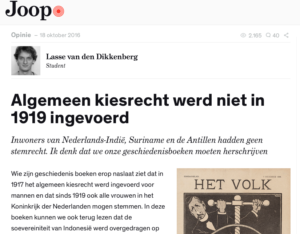Universal suffrage was not introduced to the Netherlands in 1919
Joop.nl October 18, 2016, Opinion article by: Lasse van den Dikkenberg, student Archeology Leiden University
Inhabitants of the Dutch East Indies, Surinam and the Dutch Caribbean Islands did not have voting rights after 1919. I think we should re-write our history books.
If you open a Dutch history book you will see that from 1917 all men were allowed to vote in the Netherlands. Two years later in 1919 universal suffrage was introduced giving women voting rights as well. In the same books you will read that Indonesia gained independence from the Netherlands on the 27th of December 1949. When you look at world maps from this period you will see that Indonesia and Surinam before 1949 were a part of the Kingdom of the Netherlands, this was already the case in 1919. I think we should re-write our history books because universal suffrage was not introduced in 1919 as I will demonstrate here.
First we have to clarify a few things:
1. By universal suffrage we mean a voting system in which all inhabitants of a country are allowed to vote. A democracy such as the one in Ancient Athens, where only the elite had voting rights, will not be considered a democracy with universal suffrage.
2. By the Kingdom of the Netherlands we mean the areas of the world whom are under the political control of the Netherlands. Thus between 1815-1830 Belgium was still part of the Netherlands and today we still consider Bonaire a part of the Netherlands.
3. We apply our current moral standard. This means universal suffrage was not introduced in 1917. Women were then considered to be inferior thus they were excluded from voting. From our modern viewpoint we now claim that universal suffrage was not introduced in 1917 but only in 1919 when woman also gained voting rights, even though they would have seen this differently in 1917.
After the Second World War the Netherlands (the European part) counted a population of almost 10 million inhabitants. The Dutch East Indies counted a population of about 70 million inhabitants and Surinam and the Caribbean part of the Netherlands together counted a population of less than a million. The total population numbered about 80 million people around 1945. The 70 million people in Indonesia didn’t have voting rights at this time. Thus in 1945 only 13% of the population of the Netherlands was allowed to vote. From 1949, after the independence of Indonesia, almost all people in the Netherlands were allowed to vote. But only in 2010 we can truly speak of universal suffrage. Before this period the population of the Dutch Caribbean Islands were not allowed to vote unless they spend ten years or more in the European part of the Netherlands. This rule didn’t apply to other Dutch people even if they lived outside the (European) Netherlands.
We can conclude that, when we see the non-western population of the Netherlands as our equals, universal suffrage was introduced in 2010 and not in 1919. This is a condition that we also apply to other countries. In general we accept that the USA introduced universal suffrage in the 1960’s when ethnic minorities gained voting rights. For South Africa we also accept in general that it only gained universal suffrage in 1994 after the black population also gained voting rights.
We can dwell upon the racist connotation that made us believe that the Netherlands gained universal suffrage in 1919 but it is more important to solve the problem. We have to recognize that universal suffrage was not introduced in 1919. The inhabitants of the Dutch Caribbean Islands, Indonesia and Surinam are entitled to this recognition. We cannot just depict them on our historical maps when we don’t include them in our history books. We must teach our children that the introduction of universal suffrage was a long and difficult process which was only fully completed in 2010.
[Originally published in Dutch. Translated by Lasse van den Dikkenberg. Please send us an e-mail if you think you can improve the translation: info@historibersama.com]

